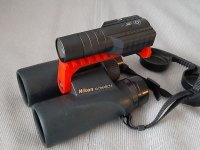wdc
Well-known member

I use 8 and 10x regularly, but more often I find I use the 10. To me it is primarily an aesthetic issue... I like the birds to be close. It is possible at long distances the 10 could make a difference in an ID, but in general I'd say 8 and 10 are pretty equal. The 8 will likely have a wider field, so may really help with quick ID on moving birds. A wider fov is a true advantage in that circumstance. In dense foliage, the 8 seems a better choice. In winter with bare trees, or a variety of types of view, including over water, the greater magnification makes it more compelling, for me anyways. That's the kind of rationale I've used, but then I'll grab the 10, when I maybe should be grabbing an 8, and its really not that big of a deal after all.
Try 10x and see for yourself. It may feel like a disadvantage if your primary goal is to ID fast moving birds.
The irony of it is that as soon as you look through a scope on a tripod at 25x or more, the difference between 8 and 10 seems rather insignificant.
Still, I seem to enjoy the 10 more often these days.
Only you can decide what works for you.
-Bill
Try 10x and see for yourself. It may feel like a disadvantage if your primary goal is to ID fast moving birds.
The irony of it is that as soon as you look through a scope on a tripod at 25x or more, the difference between 8 and 10 seems rather insignificant.
Still, I seem to enjoy the 10 more often these days.
Only you can decide what works for you.
-Bill








